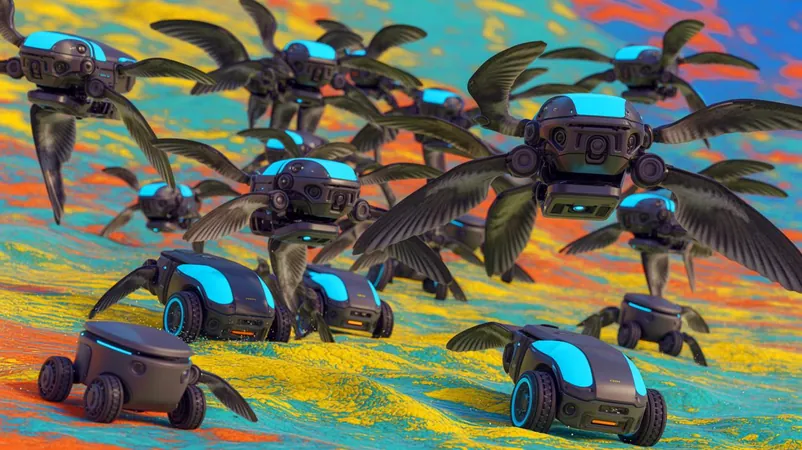
Unleashing Swarm Intelligence: The Revolutionary Framework Transforming Robot Interactions
2025-09-13
Author: Chun
Nature-Inspired Robotics Takes a Leap Forward
In a groundbreaking development in artificial intelligence, researchers are crafting a framework that enables robotic swarms to mimic the incredible cooperation seen in nature, like birds flocking and fish schooling. This innovative approach to swarm intelligence not only aims to replicate decentralized control and self-organization found in natural environments but also promises transformative applications in fields ranging from search-and-rescue missions to advanced medical drug delivery.
Decentralized Control: The Heart of Swarm Dynamics
At the core of this breakthrough lies the challenge of decentralized control. Unlike traditional systems that rely on a central authority, natural swarms operate seamlessly without a leader. Assistant Professor Matan Yah Ben Zion from Radboud University explains, "Creating a system where robots can act both independently and collectively is key. Our geometric design principles will allow these robots to work in unison without a guiding hand." Inspired by natural computation, this strategy mirrors the interactions of particles at the atomic level.
Introducing Curvity: A Game-Changer for Robotic Interaction
A pivotal innovation from this study is the concept of "curvity," a unique charge-like quality that enables robots to navigate based on external influences. Each robot is equipped with a positive or negative curvity value, determining its interaction style within the swarm. Assistant Professor Stefano Martiniani from New York University highlights how this new model allows for controlled swarm behavior, whether it’s flocking together, flowing, or clustering, transforming swarm management from complex programming to a simpler, material science endeavor.
From Concept to Reality: Practical Applications Across Industries
The implications of this new framework extend far beyond theoretical studies into tangible industrial applications. Experiments have already shown how curvature can dictate robot interactions, promising a design that can scale from individual robots to thousands working together. Industries like aerospace are already considering integrating these advancements; for example, the H2 Clipper is exploring the use of robotic swarms for aerospace manufacturing, while engineers in Pennsylvania have crafted decentralized swarming strategies for tiny robots to self-assemble complex structures.
The Medical Revolution: Precision in Drug Delivery
In medicine, the framework's potential for improving drug delivery systems is striking. By deploying microscopic robots, it becomes possible to deliver precise treatments that reduce side effects and enhance recovery outcomes. The application of swarm intelligence in healthcare showcases just one of the many transformative opportunities that lie ahead.
Looking Ahead: The Future of Swarm Robotics
The realm of robotic swarms is rapidly expanding, and the findings shared in the Proceedings of the National Academy of Sciences demonstrate its wide-ranging potential. As researchers tirelessly work to refine these systems, the simplicity of geometric rules combined with curvity presents a promising pathway to developing agile and effective robotic populations. What is certain is that the future of robotics will be shaped significantly by these advancements, transforming not just industries but everyday lives as robotic swarms become an integral part of our world.

 Brasil (PT)
Brasil (PT)
 Canada (EN)
Canada (EN)
 Chile (ES)
Chile (ES)
 Česko (CS)
Česko (CS)
 대한민국 (KO)
대한민국 (KO)
 España (ES)
España (ES)
 France (FR)
France (FR)
 Hong Kong (EN)
Hong Kong (EN)
 Italia (IT)
Italia (IT)
 日本 (JA)
日本 (JA)
 Magyarország (HU)
Magyarország (HU)
 Norge (NO)
Norge (NO)
 Polska (PL)
Polska (PL)
 Schweiz (DE)
Schweiz (DE)
 Singapore (EN)
Singapore (EN)
 Sverige (SV)
Sverige (SV)
 Suomi (FI)
Suomi (FI)
 Türkiye (TR)
Türkiye (TR)
 الإمارات العربية المتحدة (AR)
الإمارات العربية المتحدة (AR)